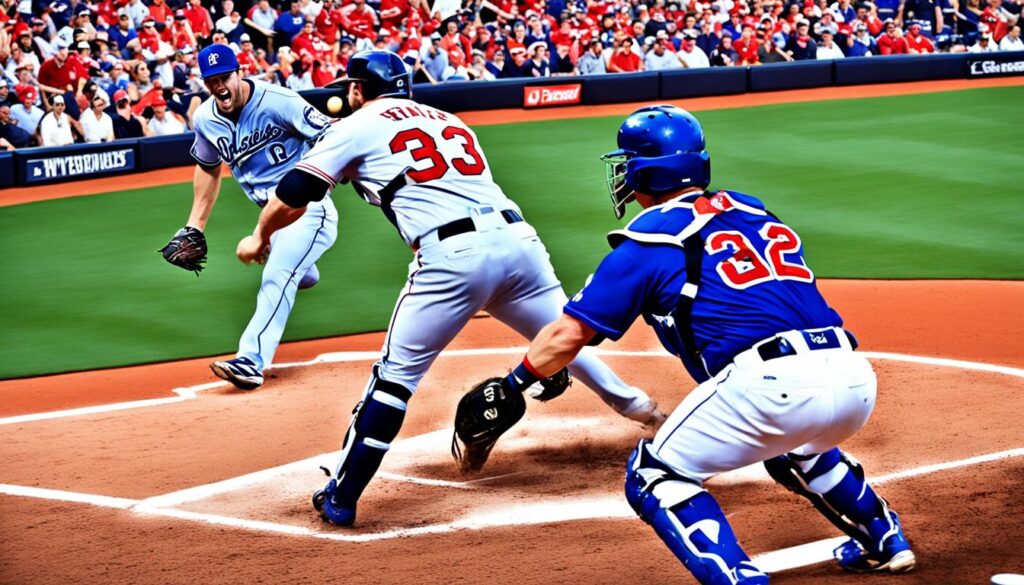
Have you ever wondered what exactly a run in baseball is? How is it scored? And why is it such a crucial part of the game? In this article, we will break down the definition of a run in baseball and explain how players score runs to contribute to their team’s success. Get ready to discover the ins and outs of baseball scoring and gain a deeper understanding of this beloved sport.
Scoring a run in baseball involves more than just running the bases. It requires players to advance around first, second, and third base and return safely to home plate, touching the bases in that order before three outs are recorded. A run can be accomplished in various ways, such as hitting a home run or utilizing a combination of hits, steals, and timely plays to bring a player safely home. Ultimately, the objective is for a team to score more runs than its opponent, paving the way for victory.
Key Takeaways:
- A run in baseball is scored when a player advances around the bases and returns safely to home plate before three outs are recorded.
- Runs can be scored by hitting a home run or through a combination of plays that put a player safely on base and subsequently bring them home.
- The objective of the game is for a team to score more runs than its opponent.
How Do Runs Work in Baseball?
Understanding how runs work in baseball is fundamental to appreciating the game. According to the official baseball rules, a run is not counted if the third out of an inning is a force out of a runner advancing to any base. However, if the third out is a tag out and another baserunner crosses home plate before the tag out is made, the run will count.
Runs scored are an important individual batting statistic that reflects a player’s ability to contribute to their team’s offense. However, they are generally considered less significant than runs batted in (RBIs). Runs scored and RBIs are both context-dependent and can vary based on the situation.
Baseball’s scoring system adds an interesting layer of strategy and decision-making. Coaches and players must calculate the risks of certain plays, weighing the potential to score a run against the possibility of recording an out. It’s these intricacies that make baseball a riveting game.
To illustrate the significance of the topic, consider this quote from legendary baseball player Babe Ruth:
“The way a team plays as a whole determines its success. You may have the greatest bunch of individual stars in the world, but if they don’t play together, the club won’t be worth a dime.”
To visualize the concept further, here is an image that highlights the basic elements of scoring a run in baseball:
Now that you have a better understanding of how runs work in baseball, let’s dive into the specifics of scoring a run in the next section.
Scoring a Run in Baseball
To score a run in baseball, a player needs to successfully touch all four bases in the correct order and return safely to home plate before the defensive team records three outs. This can be achieved by hitting the ball and running to first base, then advancing to second, third, and eventually home. A run is credited to a player who completes this sequence. If the ball is hit out of the playing field in fair territory, it is a home run and all runners on base score.
In baseball, runs are the currency of the game. They represent a team’s ability to successfully navigate the bases and bring players home, ultimately determining the outcome of a match. A run can be scored through a combination of hitting, baserunning, and smart play on the field. It is a pivotal moment in the sport, celebrated by players and fans alike.
Baseball Run Scoring Records
When it comes to baseball run scoring records, some players and teams have left an indelible mark in the history of the game. Let’s take a look at some of the notable records in runs scored.
Rickey Henderson holds the career record for most runs scored by a major-league player with 2,295. Known for his speed and ability to get on base, Henderson’s record is a testament to his exceptional career in baseball.
In terms of single-season records, the record for most runs scored in a season belongs to Billy Hamilton who scored 198 runs in 1894. Hamilton’s record still stands to this day and showcases his exceptional performance during that particular season.
Another legendary player, Babe Ruth, achieved a modern-day record of 177 runs in 1921. Ruth’s record-breaking season solidified his reputation as one of the greatest hitters in baseball history.
Babe Ruth also holds the record for the most seasons leading the league in runs scored, topping the category with 8 seasons. This remarkable achievement further demonstrates Ruth’s offensive prowess and impact on the game.
Shifting our focus to team records, the Boston Beaneaters set an incredible mark by scoring 1,212 runs in a single season in 1894. Their offensive dominance that year remains unmatched to this day.
However, if we consider modern-day records, the New York Yankees hold the record for the most runs scored in a single season with 1,067 runs in 1931. The Yankees, renowned for their powerful lineups, showcased their offensive firepower during that memorable season.
These baseball run scoring records serve as milestones in the sport, highlighting the exceptional performances of both individual players and teams throughout history.

Understanding Baseball Scoreboards
Baseball scoreboards provide essential information about the game, allowing fans to keep track of the progress and excitement on the field. These scoreboards display various data points that help enthusiasts stay informed and engaged throughout the game.
When you glance at a baseball scoreboard, you’ll typically see:
- The team names or logos: Identifying the teams involved in the game.
- The current inning and its position: Indicating whether it’s the top or bottom half of the inning.
- The number of runs scored by each team: Showing the total runs earned by the home team and the visiting team.
- The number of hits: Reflecting the number of successful hits made by both teams.
- The number of errors: Displaying any defensive mistakes made by either team.
- The number of runners on base: Illustrating the number of players currently occupying first, second, and third base.
Advanced scoreboards may offer more detailed statistics to provide deeper insights into the game. These extra statistics can include:
- Pitch speed: Revealing the velocity of each pitch thrown by the pitchers.
- Pitch count: Informing fans and coaches of the number of pitches thrown by each pitcher.
- Player-specific information: Highlighting individual player statistics, such as batting average or strikeouts.
Aside from the essential data, scoreboards may also serve additional purposes:
- Displaying messages: Sharing important announcements or encouraging fans to support their teams.
- Player photos: Featuring images of players for recognition and identification purposes.
- Replays: Showing significant moments or exciting plays from the game.
- Advertisements: Promoting products or services from sponsors.
“The electrifying atmosphere in a baseball stadium is enhanced by the information provided on the scoreboard. It keeps fans engaged and adds to the overall experience of watching America’s pastime.”
As you follow the game, you’ll notice that the end of an inning is marked by a slash at the bottom right corner of the last player’s box in the scoring grid. This visual cue signals the completion of that inning and prepares you for the next inning of play.
Now that you have a better understanding of what you can find on a baseball scoreboard, you’ll be well-equipped to fully enjoy the game and stay up to date with all the action on the field.
Conclusion
Scoring a run in baseball is a fundamental aspect of the game that involves a player successfully navigating around the bases and returning to home plate before the opposing team can record three outs. Runs hold great significance in determining the outcome of a game and serve as a measure of offensive contributions for individual players. Understanding the basics of scoring runs and how they are displayed on scoreboards can greatly enhance the enjoyment of watching and following baseball.
A run is scored when a player successfully advances around first, second, and third base, and subsequently returns to home plate, touching the bases in the correct order. This can be achieved through hits, stolen bases, sacrifice flies, or any combination of plays that result in a player reaching home safely. In the context of the game, the objective is for a team to score more runs than their opponent, ultimately leading to victory.
Through the years, notable players have set impressive run-scoring records, such as Rickey Henderson who holds the career record with 2,295 runs scored. Understanding these records adds depth to the appreciation of the sport and showcases the athletic achievements of legendary players. Additionally, baseball scoreboards provide valuable information to fans, displaying the names or logos of the teams, the current inning, the number of runs scored by each team, and additional statistics that enhance the overall viewing experience.
Source Links
- https://en.wikipedia.org/wiki/Run_(baseball)
- https://keepthescore.com/blog/posts/baseball-scoring/
- https://dt5602vnjxv0c.cloudfront.net/portals/24762/docs/baseball_scorekeeping_101.pdf

Meet Daniel Anderson, the heart and soul behind Baseball Pro Picks. At 49, Daniel’s life has revolved around baseball, a passion that’s as strong today as it was when he first fell in love with the game. Living in the USA, Daniel has dedicated countless hours to watching, analyzing, and understanding every pitch, hit, and home run, making almost no game missed. His deep-rooted love for the sport is matched only by his commitment to sharing insightful, expert analysis with fellow baseball enthusiasts. With decades of experience and a keen eye for the game’s nuances, Daniel brings a unique perspective that enriches Baseball Pro Picks. Trust Daniel to guide you through the intricacies of baseball with the authority and trustworthiness of a true aficionado.


